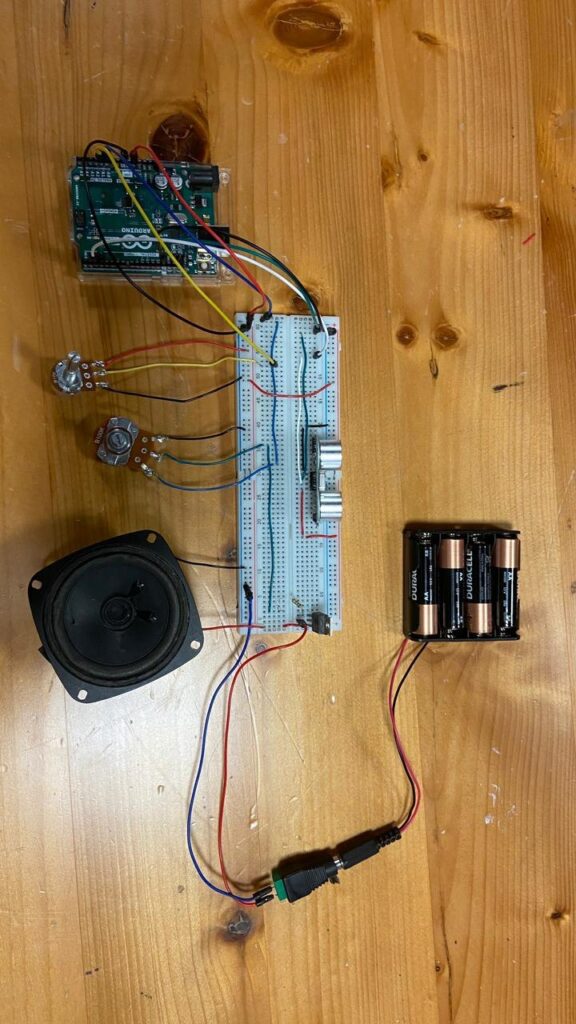Concept
It took a while for us to come up with a properly functioning musical instrument with a decent sound. At first, we tried to incorporate an ultrasonic sensor for controlling the height of a sound, a servo motor to create a beat, and a flex sensor for controlling the duration of the notes. It turned out to be fine, but we weren’t satisfied with the quality of the sound or its instability. After a little experimenting, we finally decided to use transistors to amplify the sound, which gave the music a feel of the techno genre.
Technical structure
We used the ultrasonic sensor to control the height of a sound. The B10K potentiometer controls the duration of the note, while the B100K potentiometer controls the volume of the sound. The potentiometer, as mentioned earlier, amplifies the sound.

We decided to use a transistor to amplify the signal to the speaker. Moreover, we added an external 9V power supply to power the speaker, and these additions greatly enhanced the volume and clarity of the sound. The potentiometer controlling the volume is connected in series with the input signal to the speaker from the Arduino, and so the physical reduction of the voltage of the signal by adjusting the resistance of the potentiometer controls the volume. Therefore, we use the potentiometer as a variable resistor instead of an input here.
On the other hand, the potentiometer used for the delay is used to get analog input to the Arduino, which is then used to control the delay interval in code. This is just a way to showcase the different use cases of the same components.
Video demonstration:
Code
int mapDistanceToIndex(float distance) {
// Map distances into array index (2 cm steps from 5 cm to 15 cm)
// int index = constrain((distance - MIN_DIST) / 2, 0, ARRAY_LENGTH - 1);
int dist = int(distance);
int index = constrain(map(dist, MIN_DIST, MAX_DIST, 0, ARRAY_LENGTH - 1), 0, ARRAY_LENGTH - 1);
return index;
}
void loop() {
float dist = getDistance();
noteDuration = map(analogRead(OFFSET_DIMMER), 0, 1023, 100, 500);
if (millis() - noteStartTime >= noteDuration) {
// noTone(SPEAKER_PIN);
// delay(10);
// Play a funky note continuously based on the distance range
if (dist >= MIN_DIST && dist <= MAX_DIST) {
int note = FUNKY_NOTES[mapDistanceToIndex(dist)];
Serial.print(dist);
Serial.print("cm ");
Serial.print(note);
Serial.print("HZ");
Serial.print(" with duration = ");
Serial.print(noteDuration);
Serial.println();
// Check if the note duration has elapsed, then check for a new note
// If the note has changed, start a new note
if (note != lastNote) {
lastNote = note;
tone(SPEAKER_PIN, note);
noteStartTime = millis(); // Record the start time of the current note
}
} else {
noTone(SPEAKER_PIN);
}
}
Reflection
We have succeeded in creating a new instrument that wouldn’t just become the replication of already existing ones. Furthermore, we had a chance to experiment with new sensors and get experience working with transistors and potentiometers, implementing them in one project. We believe there’s more potential for this project, especially if we could use mp3 files. Nevertheless, we had fun working on this project, experimenting with Arduino.
